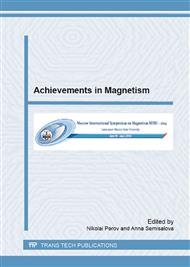p.733
p.737
p.741
p.745
p.750
p.757
p.761
p.766
p.771
To the Theory of Hyperthermia Effect Induced by Magnetic Nanoparticles
Abstract:
In this paper, we present results of theoretical modeling of the rise of temperature for the unit of time in a dilute suspension of the fiber ferromagnetic particles under the action of the linearly polarized oscillating magnetic field. Two mechanisms of the heat production, namely the particle rotation in the liquid and its internal remagnetization are considered. We study effect of the particle shape, its magnetic properties and rheological properties of the carrier liquid on the rise of temperature for the unit of time by the particles.
Info:
Periodical:
Pages:
771-775
Citation:
Online since:
July 2015
Authors:
Price:
Сopyright:
© 2015 Trans Tech Publications Ltd. All Rights Reserved
Share:
Citation:


